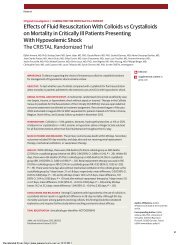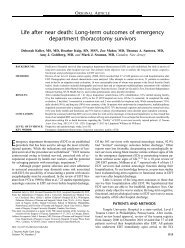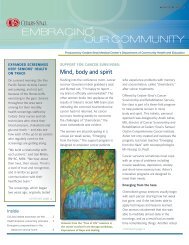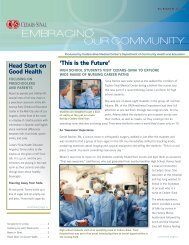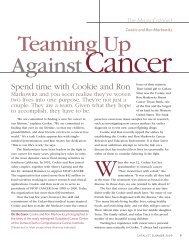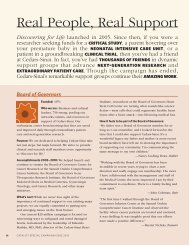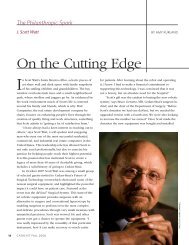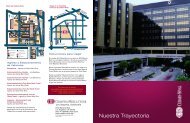Barium Test - Cedars-Sinai
Barium Test - Cedars-Sinai
Barium Test - Cedars-Sinai
You also want an ePaper? Increase the reach of your titles
YUMPU automatically turns print PDFs into web optimized ePapers that Google loves.
Cancer Program<br />
IMAGING: BARIUM TESTS<br />
<strong>Barium</strong> Swallow<br />
A barium swallow is performed to assess frequent<br />
heartburn (pain), gastric reflux (food/acid coming back<br />
up), aspiration (food and/or fluid in the windpipe) and<br />
difficulty eating, drinking or swallowing.<br />
<strong>Barium</strong> Enema<br />
This exam assesses a change in bowel habits,<br />
abdominal pain or rectal bleeding and suspected<br />
diverticulitis (small inflamed areas in the colon) or<br />
polyps (growth of tissue on the colon).<br />
What to expect<br />
■ Before the exam:<br />
The patient may not eat or drink from midnight<br />
before the exam.<br />
■ During the exam:<br />
For the first portion of the test, the patient stands<br />
upright and drinks a cup of barium. Using a<br />
fluoroscope (X-ray unit combined with a television<br />
screen), the radiologist watches the flow of liquid as<br />
it moves from the mouth to the stomach, while the<br />
patient slowly turns in different positions.<br />
For the second portion of the procedure, the patient<br />
lies facedown on the exam table and drinks more<br />
barium. The radiologist takes additional pictures,<br />
and the technologist takes an additional series of<br />
standard X-rays. The entire procedure takes<br />
approximately 60 minutes.<br />
■ After the exam:<br />
The patient must drink plenty of liquids for 24 to<br />
48 hours. The barium may make a patient’s stool<br />
white for several days. If constipation occurs, the<br />
doctor may recommend a mild laxative.<br />
What to expect<br />
■ Before the exam:<br />
For a satisfactory exam, the colon must be empty.<br />
The patient must follow a restricted diet, take a<br />
laxative the night before the exam and refrain from<br />
eating and drinking from midnight the day of the<br />
exam. On the morning of the procedure, the patient<br />
is given a final cleansing with a Fleet enema.<br />
■ During the exam:<br />
For the procedure, the patient lies on an exam table.<br />
The technologist takes an initial film to make sure<br />
the intestines are clean. Once the film has been<br />
reviewed by the radiologist, the technologist inserts a<br />
lubricated enema tip into the rectum and allows the<br />
liquid barium to flow through the enema tip a little<br />
at a time. <strong>Barium</strong> allows viewing of the colon. The<br />
radiologist watches the flow of the barium with a<br />
fluoroscope (X-ray unit combined with a television<br />
screen). The patient is asked to turn from side to<br />
side as the pictures are being taken to help coat the<br />
walls of the colon. The technologist takes a series of<br />
(Continued on reverse)
X-ray pictures of the colon. The patient must try not<br />
to expel the barium and must remain very still as<br />
pictures are being taken. The exam takes<br />
approximately 45 minutes.<br />
■ After the exam:<br />
The patient must drink plenty of liquids for 24 to 48<br />
hours. The barium may make a patient’s stool white<br />
for several days. If constipation occurs, the doctor may<br />
recommend a mild laxative.<br />
<strong>Barium</strong> Enema with Air Contrast<br />
■ Before the exam:<br />
For a satisfactory exam, the colon must be empty. The<br />
patient must follow a restricted diet, take a laxative the<br />
night before the exam and refrain from eating and<br />
drinking from midnight the day of the exam. On the<br />
morning of the procedure, the patient is given a final<br />
cleansing with a Fleet enema.<br />
fluoroscope (X-ray unit combined with a television<br />
screen). The patient is asked to turn from side to side<br />
as the pictures are being taken to help coat the walls of<br />
the colon. The radiologist then introduces air into the<br />
colon through the same enema tip, which may cause<br />
cramping or a bloating sensation. The air is used to<br />
expand the walls of the colon for a more detailed<br />
look at the lining. The technologist takes a series of<br />
X-rays of the colon. The patient must try not to<br />
expel the air or the barium and must remain very<br />
still as pictures are being taken. The exam takes<br />
approximately 45 minutes.<br />
■ After the exam:<br />
The patient must drink plenty of liquids for 24 to 48<br />
hours. The barium may make a patient’s stool white<br />
for several days. If constipation occurs, the doctor may<br />
recommend a mild laxative.<br />
■ During the exam:<br />
For the procedure, the patient lies on an exam table,<br />
while the technologist takes an initial film to make<br />
sure the intestines are clean. Once the film has been<br />
reviewed by the radiologist, the technologist inserts a<br />
lubricated enema tip into the rectum and allows the<br />
liquid barium to flow through the enema tip a little at<br />
a time. <strong>Barium</strong> allows viewing of the colon. The<br />
radiologist watches the flow of the barium with a<br />
CP0200 073003



